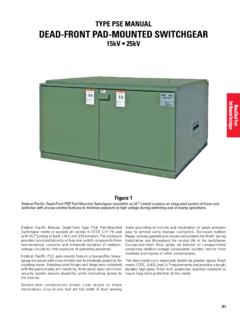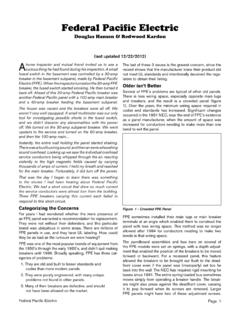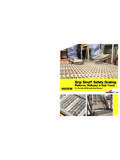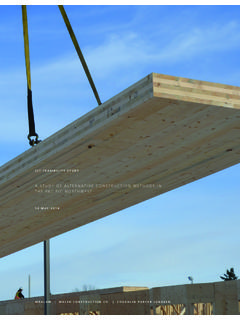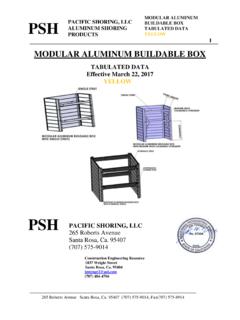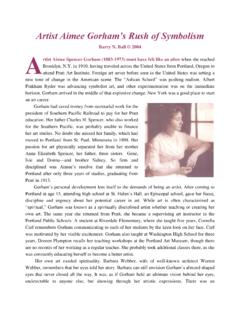Transcription of FPE Panels – Hazard or Hype? by Douglas Hansen
1 federal pacific Panels Page 1 of 7 FPE Panels Hazard or hype ? by Douglas Hansen This article focuses on the controversy over inspecting and reporting federal pacific Panels . It has been published in the maga-zine for the California Real Estate Inspec-tion Association and in other technical jour-nals. FPE Panels Hazard or hype ? federal Electric later known as federal pacific Electric (FPE) was a popular manufacturer of Panels and breakers from the mid-1950 s until the early 1980 s.
2 Based in New Jersey, their products were very popular throughout the counry, and some communities have FPE Panels in almost every home. For years, stories have circu-lated about the hazards and defects unique to this equipment, and the darker rumors include tales of product recalls, fraudulent manufacturing, and house fires resulting from failed breakers. Inspectors and electri-cians share tales of breakers falling out of Panels when the deadfront is removed, or breakers failing to shut off when the handle is operated.
3 Home inspectors need the facts so they can present their clients with accu-rate information on which to base a decision on accepting or replacing FPE Panels . Problems with FPE Panels can be broken down into 3 basic categories: First, there is the simple fact that the equipment is old, and manufactured to less stringent codes and standards than modern equipment. Electrical equipment is not something that improves with age or use. Second, there are problems unique to the design of the FPE Stablok breakers, problems that are not found in other equipment this age.
4 Third, there are issues of manufacturing defects and circuit breaker failures. This last issue causes the greatest concern; what good is a circuit breaker that won t trip when overloaded or shorted? What good is a breaker that doesn t de-energize the circuit when the handle is tripped? Older isn t Better Several of the problems found with FPE Panels are found in other brands of equip-ment of the same age. There is less gutter space in the panel than we find in modern equipment. The result is crowding of the wires in the Panels .
5 It is sometimes impos-sible to see all of the terminals in an FPE panel. The space for bending wires is also less than required in modern Panels . The rules that proscribe minimum wire bending space are found in the National Electrical Code (NEC) in section in the 2002 edition. Over the years, the required mini-mum space has increased, with the most significant changes in the 1981 NEC, near the very end of the days when FPE Panels were made. FPE manufactured some pan-els with less clearance than the minimum code rules by installing the lugs at an angle, so the conductor was already parallel to the wall opposite the breaker terminal (figure 1).
6 However, the bends shown in figure 1 de-feat the purpose of the angled lugs, and the wire is bent too sharply. Figure 1 Insufficient wire bending space federal pacific Panels Page 2 of 7 The bus bars on several of the FPE models were set on springs, with a depth adjust-ment that enabled the position of the break-ers to be moved forward or backward. For a recessed panel, this feature allowed the breakers to be brought out flush to the deadfront cover even if the panel set too far back into the wall.
7 The code today does not allow this, and states that bus bars must be rigidly mounted (section ). Rigid mounting prevents the entire bus from mov-ing when a single breaker handle is oper-ated. Another problem with spring-mounted bus bars is that the breakers sometimes push against the deadfront cover, creating a danger to the inspector when they remove and put back the deadfront cover. Since the 1984 edition of the NEC, breakers that operate with their handles in a vertical position must be on when in the up position, and off in the down position.
8 Prior to that time, several manufacturers made equip-ment such as that seen in figure 2, with a row of breakers that was on when down and off when up. The word on when upside down is no. Inspectors encountering such equipment might want to warn their clients that these FPE breakers are on when facing the outer edge of the panel, and off when facing the center of the panel. It can be very difficult to remove these covers without ac-cidentally tripping a breaker. Figure 2 Breakers that are on when down Prior to 1984, many manufacturers offered split bus Panels for residential use, such as the panel in figure 3.
9 These Panels have no main breaker. They do meet the rule re-quiring no more than 6 disconnects, and one of these disconnects feeds a separate bus that typically contains the 15 and 20 amp 120 volt circuits. The advantages of a split bus panel were purely economic. If the largest breaker was the one feeding the secondary bus, and it was rated at 50 amps, it cost less than a single main 100 amp breaker. In addition to the six disconnects rule for service equipment, another rule also applies to Panels that are categorized as lighting and appliance Panels .
10 These are Panels where more than 10% of the break-ers are rated 30 amps or less and serve cir-cuits with neutrals. These lighting and appli-ance Panels must be capable of having their power disconnected by not more than 2 hand movements. Until 1984, the code ex-empted these Panels from the two-disconnects rule when they served as resi-dential service equipment. Today, the code allows them to remain when they are exist-ing service equipment, though it would not allow a new installation of such a panel.


